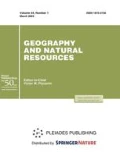Abstract
We examine the age structure of the population as one of the main indicators that characterize the dynamics of demographic potential development. The age structure of the population of Asian Russia and neighboring territories of Kazakhstan, Mongolia, and China has been assessed based on statistical analysis (2010–2019). The triple coding method was employed for cartographic representation of the spatial and demographic dynamics. This method is based on the triangular Pere diagram, where demographic parameters are synthesized and have their own color code. The color scale of age structures of the population is represented as follows: yellow indicates the population older than the employable age, blue is the employable population, and purple is the population younger than the employable age. Based on the results we obtained, we suggest a classification of the regional age structure of the population in the Asian part of Russia and border regions of Kazakhstan, Mongolia, and China and generate schematic maps to visualize spatio-temporal changes in the demographic structure of the population in these regions. This research indicates that the triple coding method is complete and informative and has applied significance.




Similar content being viewed by others
REFERENCES
Sharilova, E.E., Statistical assessment and analysis of the demographic significance of the age structure of the population of the Republic of Belarus, Vopr. Stat., 2015, no. 3, pp. 48–52.
Prakticheskaya demografiya: Uchebnoe posobie dlya vuzov (Practical Demography: Handbook), Rybakovskii, L.L., Ed., Moscow: TsSP, 2005.
Byuraeva, Yu.G., What is the relationship between the demographic potential and the economic development of the Republic of Buryatia?, EKO, 2019, no. 6, pp. 124–144.
Vorob'ev, N.V. and Vorob’ev, A.N., Formation of the population, in Geografiya Sibiri v nachale XXI veka (Geography of Siberia in the Early 21st Century), Novosibirsk: Akad. Izd. Geo, 2014, pp. 134–155.
Grigorichev, K.V., New birthrate trends in the Siberian region (Irkutsk oblast), Etnodemograficheskie protsessy v Kazakhstane i sopredel’nykh territoriyakh: Sb. nauch. trudov XI Mezhdunar. nauch.-prakt. konf., 28–29 maya 2010 g. (Ethnodemographic Processes in Kazakhstan and Adjacent Territories: Proc. XI Int. Sci.-Pract. Conf., May 28–29, 2010), Ust-Kamenogorsk: Librius, 2010, pp. 115–127.
Grigorichev, K.V. and Savin, S.P., Change in the age model of birthrate: The case of Irkutsk oblast, Fundam. Issled., 2014, no. 12, part 6, pp. 1338–1342.
Dmitrieva, Yu.N., Study of the age characteristics of the population of Baikal oblast, Geograficheskie issledovaniya Aziatskoi Rossii i sopredel’nykh territorii: Novye metody i podkhody: Materialy Mezhdunar. konf., Irkutsk, 1–3 oktyabrya 2019 g. (Geographic Studies of Asian Russia and Adjacent Territories: New Methods and Approaches: Proc. Int. Conf., Irkutsk, October 1–3, 2019), Irkutsk: Irkutsk. Univ., 2019, pp. 82–87.
Dmitrieva, Yu.N., Changes in the demographic structure of the population of Irkutsk oblast, Geogr. Prir. Resur., 2019, no. 5, pp. 178–184.
Eremin, A.A., Dynamics and territorial differentiation of the regional demographic situation at the present stage, Extended Abstract of Cand. Sci. (Geogr.) Dissertation, Barnaul. http://dissercat.com. Accessed March 14, 2020.
Nefedova, T.G., New Moscow outside its cities, in Staraya i novaya Moskva: Tendentsii i problemy razvitiya: Sb. nauch. statei (Old and New Moscow: Trends and Development Problems: Collection of Scientific Articles), Moscow: IP Matushkina I.I., 2018, pp. 184–218.
Soboleva, S.V., Demographic situation in Siberia in the context of nationwide trends, Reg. Res. Russ., 2015, vol. 5, pp. 154–162.
Sukneva, S.A., Demographic potential of population reproduction in the northern region (on the example of the Republic of Sakha (Yakutia)), Extended Abstract of Doctoral (Econ.) Dissertation, Moscow, 2011.
Tinikova, E.E., The age and sex structure of the population of the cities of Southern Siberia in the mid 20th – early 21st century, Genesis: Istor. Issled., 2019, no. 2, pp. 74–87.
Treivish, A.I., Unevenness and structural diversity of the economy’s spatial development as a scientific problem and Russian reality, Reg. Res. Russ., 2019, vol. 10, pp. 143–155.
Ryashchenko, S.V., Regional disparities in the qualitative characteristics of the population of Asian Russia, Geogr. Prir. Resur., 2011, no. 1, pp. 20–26.
Novoselova, S.V. and Denisenko, M.B., Osnovy demografii: Posobie dlya gos. sluzhashchikh (Fundamentals of Demography: A Guide for State Employees), Minsk: Al’tiora - Zhivye Kraski, 2012.
Gasnikov, V.K., Strelkov, N.S., Zabrodin, N.A., Popova, N.M., Gasnikov, K.V., Sadilova, P.Yu., and Lisina, E.B., Demographic burden and working-age population: Long-term dynamics and current state, Med. Al’m., 2012, no. 4, pp. 9–12.
Romashova, T.V., Geografiya naseleniya s osnovami demografii: Praktikum (Population Geography with Basics of Demography: Practical Guide), Tomsk: Tomsk. Univ., 2014.
World Economic and Social Survey 2007: Development in an Ageing World, New York: UN, 2008.
Olson, J.M., Color and the computer in cartography, in Color and the Computer, Boston: Acad. Press, 1987, pp. 205–219.
Elshina, I.A., Labor activity of the population of the “third age” in the context of demographic aging of the population (on the example of the Republic of Sakha (Yakutia)), Strategiya Ustoich. Razvit. Reg. Ross., 2015, no. 28, pp. 124–131.
Funding
This work was carried out within the framework of the budget project of the Baikal Institute of Nature Management of the Siberian Branch of the Russian Academy of Sciences (AAAA-A19-119060390027-8) and with partial financial support from the Russian Foundation for Basic Research (18-55-91047/20 Mong_omi, 19-55-44020 Mong_t, and 20-55-53030 GFEN_a).
Author information
Authors and Affiliations
Corresponding authors
Additional information
Translated by K. Lazarev
Rights and permissions
About this article
Cite this article
Ayusheeva, V.G., Batomunkuev, V.S., Zangeeva, N.R. et al. A Spatial Analysis of the Population Age Structure of Asian Russia and Neighboring Territories. Geogr. Nat. Resour. 42, 17–23 (2021). https://doi.org/10.1134/S1875372821010042
Received:
Revised:
Accepted:
Published:
Issue Date:
DOI: https://doi.org/10.1134/S1875372821010042




